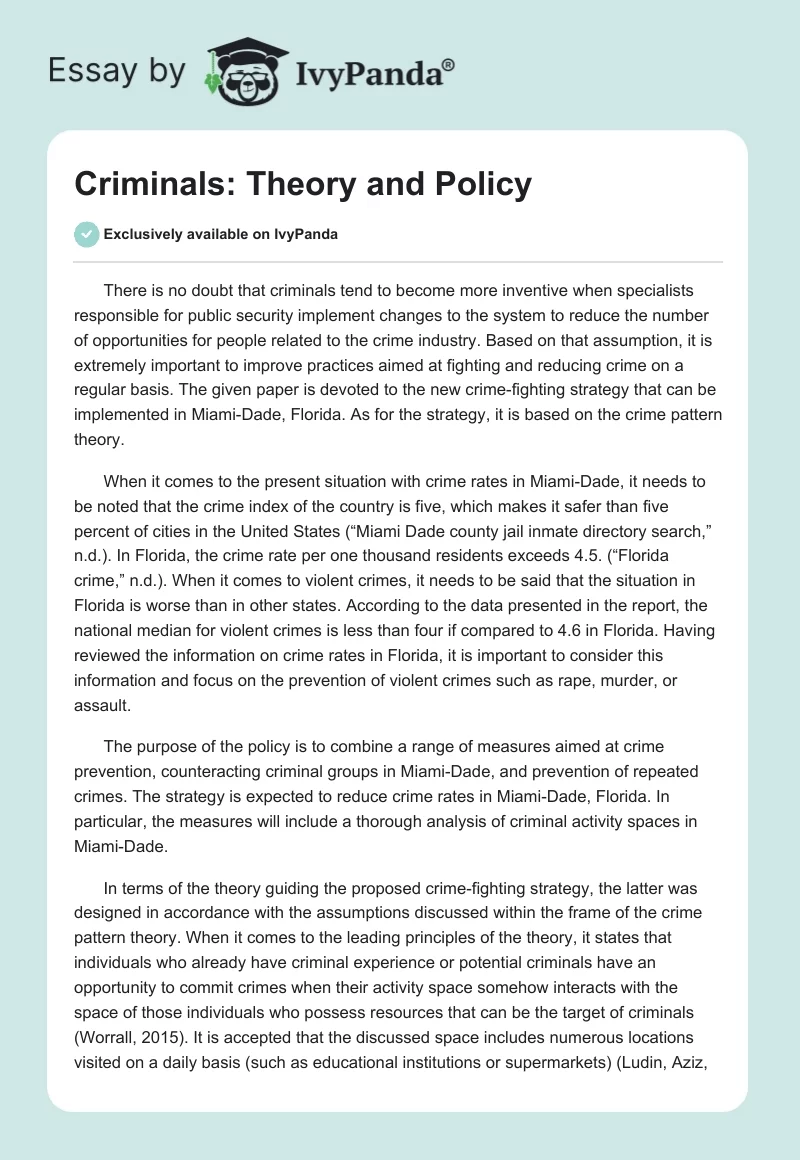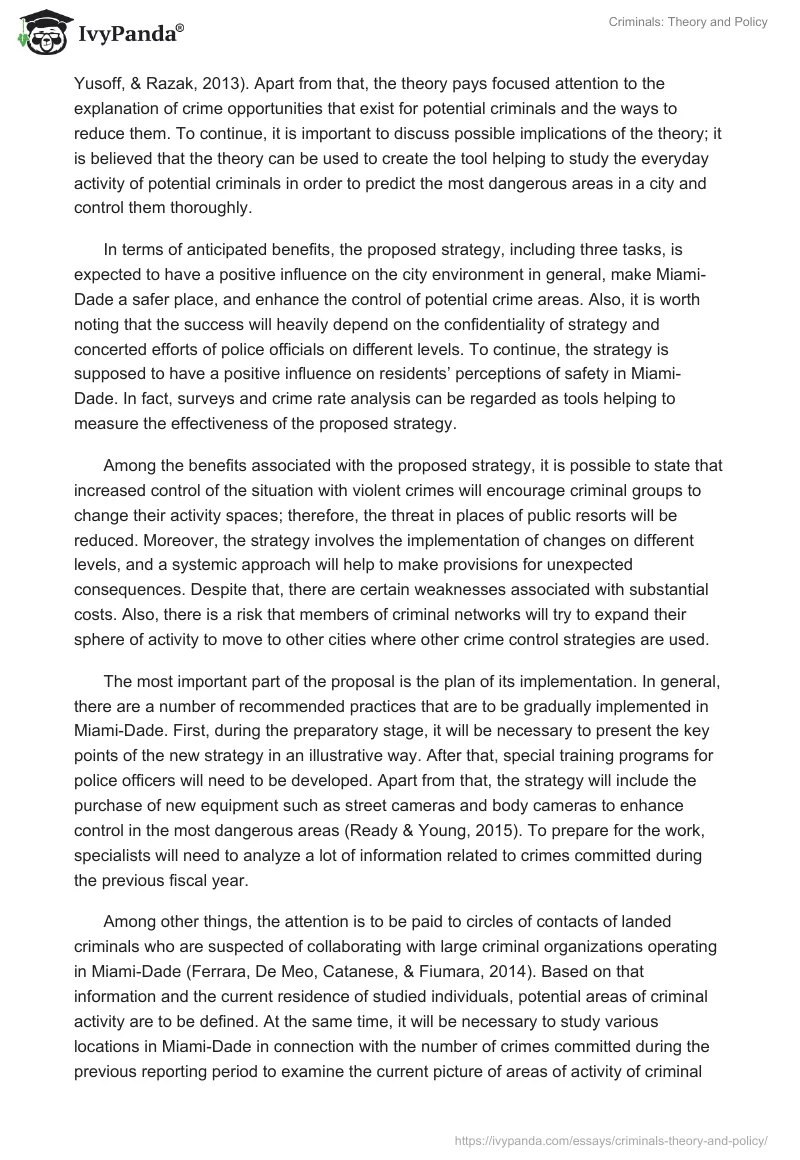There is no doubt that criminals tend to become more inventive when specialists responsible for public security implement changes to the system to reduce the number of opportunities for people related to the crime industry. Based on that assumption, it is extremely important to improve practices aimed at fighting and reducing crime on a regular basis. The given paper is devoted to the new crime-fighting strategy that can be implemented in Miami-Dade, Florida. As for the strategy, it is based on the crime pattern theory.
When it comes to the present situation with crime rates in Miami-Dade, it needs to be noted that the crime index of the country is five, which makes it safer than five percent of cities in the United States (“Miami Dade county jail inmate directory search,” n.d.). In Florida, the crime rate per one thousand residents exceeds 4.5. (“Florida crime,” n.d.). When it comes to violent crimes, it needs to be said that the situation in Florida is worse than in other states. According to the data presented in the report, the national median for violent crimes is less than four if compared to 4.6 in Florida. Having reviewed the information on crime rates in Florida, it is important to consider this information and focus on the prevention of violent crimes such as rape, murder, or assault.
The purpose of the policy is to combine a range of measures aimed at crime prevention, counteracting criminal groups in Miami-Dade, and prevention of repeated crimes. The strategy is expected to reduce crime rates in Miami-Dade, Florida. In particular, the measures will include a thorough analysis of criminal activity spaces in Miami-Dade.
In terms of the theory guiding the proposed crime-fighting strategy, the latter was designed in accordance with the assumptions discussed within the frame of the crime pattern theory. When it comes to the leading principles of the theory, it states that individuals who already have criminal experience or potential criminals have an opportunity to commit crimes when their activity space somehow interacts with the space of those individuals who possess resources that can be the target of criminals (Worrall, 2015). It is accepted that the discussed space includes numerous locations visited on a daily basis (such as educational institutions or supermarkets) (Ludin, Aziz, Yusoff, & Razak, 2013). Apart from that, the theory pays focused attention to the explanation of crime opportunities that exist for potential criminals and the ways to reduce them. To continue, it is important to discuss possible implications of the theory; it is believed that the theory can be used to create the tool helping to study the everyday activity of potential criminals in order to predict the most dangerous areas in a city and control them thoroughly.
In terms of anticipated benefits, the proposed strategy, including three tasks, is expected to have a positive influence on the city environment in general, make Miami-Dade a safer place, and enhance the control of potential crime areas. Also, it is worth noting that the success will heavily depend on the confidentiality of strategy and concerted efforts of police officials on different levels. To continue, the strategy is supposed to have a positive influence on residents’ perceptions of safety in Miami-Dade. In fact, surveys and crime rate analysis can be regarded as tools helping to measure the effectiveness of the proposed strategy.
Among the benefits associated with the proposed strategy, it is possible to state that increased control of the situation with violent crimes will encourage criminal groups to change their activity spaces; therefore, the threat in places of public resorts will be reduced. Moreover, the strategy involves the implementation of changes on different levels, and a systemic approach will help to make provisions for unexpected consequences. Despite that, there are certain weaknesses associated with substantial costs. Also, there is a risk that members of criminal networks will try to expand their sphere of activity to move to other cities where other crime control strategies are used.
The most important part of the proposal is the plan of its implementation. In general, there are a number of recommended practices that are to be gradually implemented in Miami-Dade. First, during the preparatory stage, it will be necessary to present the key points of the new strategy in an illustrative way. After that, special training programs for police officers will need to be developed. Apart from that, the strategy will include the purchase of new equipment such as street cameras and body cameras to enhance control in the most dangerous areas (Ready & Young, 2015). To prepare for the work, specialists will need to analyze a lot of information related to crimes committed during the previous fiscal year.
Among other things, the attention is to be paid to circles of contacts of landed criminals who are suspected of collaborating with large criminal organizations operating in Miami-Dade (Ferrara, De Meo, Catanese, & Fiumara, 2014). Based on that information and the current residence of studied individuals, potential areas of criminal activity are to be defined. At the same time, it will be necessary to study various locations in Miami-Dade in connection with the number of crimes committed during the previous reporting period to examine the current picture of areas of activity of criminal organizations. The information retrieved with the help of these practices is to constitute the basis for a new monitoring strategy. Within its frame, the attention will be paid both to known and potential criminal areas in Miami-Dade.
References
Ferrara, E., De Meo, P., Catanese, S., & Fiumara, G. (2014). Detecting criminal organizations in mobile phone networks. Expert Systems with Applications, 41(13), 5733-5750.
Florida crime (n.d.). Web.
Ludin, A. N. M., Aziz, N. A., Yusoff, N. H., & Razak, W. J. W. A. (2013). Impacts of urban land use on crime rate patterns through GIS application. Planning Malaysia Journal, 11(2), 1-22.
Miami Dade County jail inmate directory search. (n.d.). Web.
Ready, J. T., & Young, J. T. (2015). The impact of on-officer video cameras on police-citizen contacts: Findings from a controlled experiment in Mesa, AZ. Journal of Experimental Criminology, 11(3), 445-458.
Worrall, J. L. (2015). Crime control in America: What works? (3d edition). New York, NY: Pearson.


